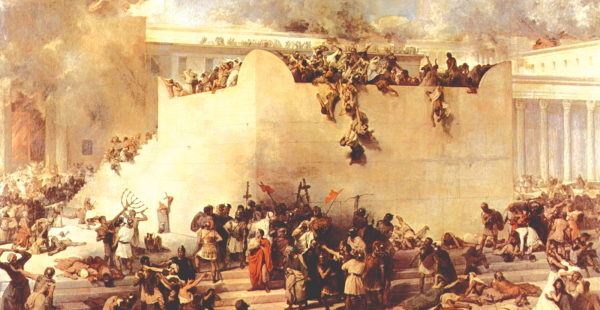
The First Jewish-Roman War
Rome and Jerusalem are not particularly deep friends. Three times they revealed their hostility to the world – in the First Jewish-Roman War, the Kitos War, and the Bar-Kochba Revolt. Both nations emerged triumphant. Rome triumphed in power, defeating the Jewish rebels, but Jerusalem triumphed in culture. Despite the hatred of Rome, the Jews managed to survive as a culture – and this is a victory of a more lasting sort.
The First Jewish-Roman War also changed the course of Christian history. It widened the rift between Jews and Christians, created a more gentile-flavored church, and many believe that it fulfilled New Testament prophecy.
Background
Judea entered the Roman Empire peacefully. The province was absorbed into the empire, starting out as an independent kingdom allied with the Romans, then a petty kingdom, then a divided tetrarchy, and only after a process of time did it become a cog in the wheel of empire. The Jews resented this loss of freedom and the imposition of taxes. Far more galling were the brutal Roman governors and procurators.
The discontent came to head in AD 66. The Roman Procurator Gessius Florus needed money, and he knew where to find it. He sent his soldiers into the Jewish Temple to remove some of the sacred treasury. The Jews responded with a weapon of their own: sarcasm. They mocked Florus as a beggar who needed Temple proceeds to survive. The procurator was not amused. When he could not find the perpetrators of the joke, he captured some passers-by and crucified them.
Initial Rebellion
This brutal action initiated a national rebellion. The Jews overran the Roman garrison in Jerusalem, and Rome responded with an invasion. The capable Roman general Vespasian began a campaign to subjugate northern Israel. Though the Jews mounted a stiff resistance, the Romans secured Galilee by AD 68, turning the focus of the war toward Jerusalem.
The Jews could not resist the Galilean invasion, but in at least one battle – the Battle of Beth Horon – they achieved unbelievable success. When they attacked a Roman legion in the middle of a mountain pass, the Roman soldiers were unable to create a formation before the smashing Jewish assault. In the confusion, almost an entire legion – the XII Fulminata – was annihilated, a loss of 6,000 troops.
If Judea was in turmoil, so was Rome. Emperor Nero committed suicide in AD 68, and general Vespasian seized the purple, leaving the Jewish campaign for his son Titus. Titus had an advisor, Josephus, who would make history in his own way. Once a Jewish general, Josephus surrendered to the Romans, prophesied their success, and became a traitor to his friends. Yet it is through this man, Josephus, that we have many of the records of this Jewish-Roman War.
Siege of Jerusalem
Jerusalem was divided by rival factions, including Sadducee authorities, mobs under John of Gischala, and mobs under Simon bar Giora. While Jerusalem’s siege was miserable, much of this misery was internal – these rival factions fought each other as much as they fought the Romans. At one point, some of the rebels destroyed the city’s food supply in an attempt to motivate the population to fight an offensive battle!
When Jerusalem began to suffer from starvation, Titus built a great palisade to prevent food from entering and Jews from leaving. Those Jews who did seek mercy from the Romans received little – every captured fugitive was crucified in sight of the city, with an average of 500 crucifixions per day.
Titus knew that it was crucial for the Romans to capture the fortress Antonia, a stronghold in the city’s defenses. The Romans broke through one wall, but the Jews were prepared – another wall was already in place behind it. Later, twenty-four Roman soldiers secretly entered the fortress and created chaos. The Roman army joined the fight, and the lofty fortress fell in ten hours of fighting.
After a total of seven months of siege warfare, the Romans finally broke through the fortifications, charging into the temple compound and slaughtering the Jews, who slipped on the blood-coated marble surface. The 500-year old Temple, which had recently completed a decades-long renovation under Herod the Great, burnt to the ground. A mass blood-fest ensued, and those who survived the slaughter, atrocities, and assault of the Roman soldiers were shipped to the imperial slave markets – nearly 100,000 in all.
Aftermath
Yet the war was not over. In the desert holds of Judea, a few more radical Jews hoped for a miracle. The nearly impregnable fortress of Masada contained a tiny garrison of less than a thousand men, women, and children. The Romans assaulted this fortress for several months, eventually building a vast ramp to the dizzying clifftop. Bursting into the fortification, they found no defenders. All had committed suicide except one woman and five children.
The First Jewish-Roman War affected the early Christian church significantly. It visibly separated Christians from Jews. Many Christians recognized this as the time that Jesus predicted – “when you see Jerusalem surrounded by armies, then know that its desolation has come near” (Luke 21:20). They literally obeyed the command to “let those who are in Judea flee to the mountains.”
The rebellion changed the nature of the church from primarily Jewish to primarily Gentile. No longer was Jerusalem the center of the church. Asia Minor (modern Turkey) became the ‘Bible belt’ of the Roman Empire, with much of the Christian emphasis centered in Ephesus. Over the centuries, this emphasis would migrate west, until the religion of Abraham and the Hebrew patriarchs had conquered Rome itself.




Josephus’ War of the Jews is captivating reading. If it were a movie it would be far more bloody and violent than the movie “Gladiator”.
Very interesting description, but still lacking unbiased refrences.